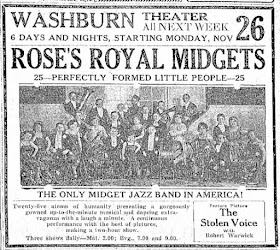 |
| Altoona Mirror, March 14, 1947 |
 |
| Altoona Mirror, Feb. 22, 1947 |
In 1947, several members of Rose's Midget Revue were injured in the Red Arrow train wreck in Altoona, Pennsylvania.
For a history of Rose's Midget Revue, see part 1.
 |
| Undated newspaper ad |
 |
| Statesville Landmark, Nov. 15, 1932 |
 |
| Undated newspaper ad |
 |
| Ike Rose, first wife Saharet, and daughter |
 |
| 1945 Billboard tribute to Ike Rose on the 10th anniversary of his death |
 |
| Rose's Midget Revue performer and fashion designer/dressmaker Hansi Herman |
 |
| Racine Journal Times, Apr. 7, 1933 |
 |
| Trade ad |
 |
| 1937-39 program of "interesting facts about little people" |
 |
| Billboard, Aug. 14, 1954 |
















































